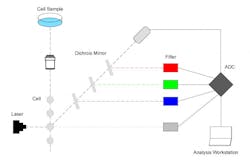Flow cytometry represents a groundbreaking technique facilitating the comprehensive analysis of cells or particles in a high-throughput manner. By leveraging principles such as hydrodynamic focusing, electronic detection, and advanced optical systems, flow cytometry offers invaluable insights into cell populations, surface markers, and intricate cellular characteristics. This article delves into the fundamental principles of flow cytometry, encompassing its fluidic system, electronic detection system, equipment, and optical system. A grasp of these principles is indispensable for the effective utilization of flow cytometry across diverse fields, from immunology research to clinical diagnostics and beyond.
Understanding the Fundamentals
- Fluidic System: Utilizing Hydrodynamic Focusing: Central to the operation of flow cytometry is the fluidic system, specifically emphasizing hydrodynamic focusing. This principle guarantees that cells or particles traverse through the flow cytometer’s examination area individually, thereby enhancing the accuracy and precision of measurements. Various flow rates are utilized for different types of analyses, spanning from qualitative evaluations like surface marker-based phenotyping of cell populations to more intricate examinations such as cellular and DNA analysis.
- Electronic Detection System: Within the realm of flow cytometry, the electronic detection system stands as a critical component. It serves to measure a diverse range of properties associated with cells or particles. Forward-scattered light (FSC) and side-scattered light (SSC) play pivotal roles in providing insights into particle size and complexity/granularity, respectively. These measurements of light scatter are essential for gaining a comprehensive understanding of cellular properties.
- Equipment: Flow cytometers are equipped with various components to ensure efficient detection and analysis. Photomultiplier tubes (PMTs) capture weak SSC and fluorescence signals with high sensitivity, while photodiodes detect stronger FSC signals. Optical System: The optical system plays a pivotal role in routing and collecting light signals accurately. Excitation optics, comprising lasers and lenses, focus the laser beam onto the sample, while emission optics, including lenses, mirrors, filters, and beamsplitters, collect scatter and fluorescence signals for precise detection.
Applications and Contributions
Flow cytometry serves as a versatile technique offering unparalleled insights into the world of cells or particles. By comprehending the principles of hydrodynamic focusing, electronic detection, equipment, and optical systems, researchers and clinicians can harness its full potential. Shanghai Optics plays a vital role in advancing flow cytometry by providing specialized optical components and services tailored to the unique requirements of flow cytometers. Key contributions include:
- Optical Coatings: Applying customized optical coatings to enhance performance in flow cytometry applications.
- Custom Optics: Designing and producing custom optics optimized for specific wavelengths and applications.
- Optical System Integration: Assisting in the integration and alignment of optical components within flow cytometers.
- Laser Selection and Optimization: Assisting in laser selection and optimizing laser performance for optimal excitation efficiency.
- Polarization Optics: Providing polarizing components to optimize polarization measurements for comprehensive cellular characterization.
- Fluorescence Filters: Developing and supplying fluorescence filters for accurate fluorescence signal detection.
These contributions enhance the capabilities of flow cytometry instruments, leading to improved accuracy, sensitivity, and versatility in cellular analysis and research.
Do not hesitate to contact Shanghai Optics today. We’d be more than happy to discuss your projects and how best they can become a success.

